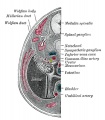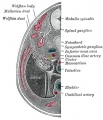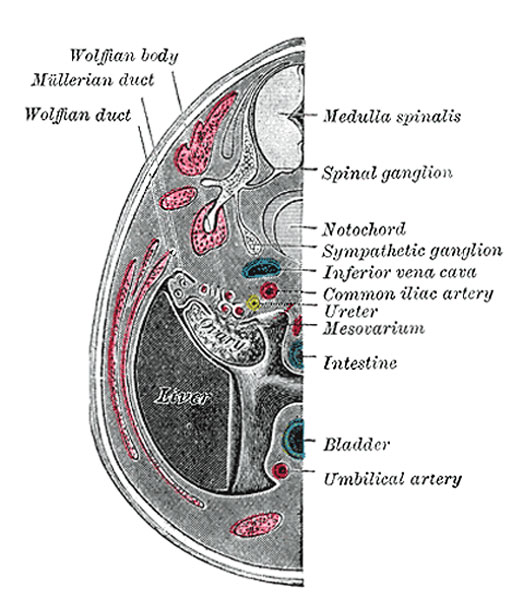File:Gray1111.jpg
From Embryology
Gray1111.jpg (523 × 600 pixels, file size: 66 KB, MIME type: image/jpeg)
Transverse section of Human Embryo 8.5 to 9 Weeks Old
(From model by Keibel.)
- first appearance of the genital gland is essentially the same in the two sexes
- a thickening of the epithelial layer which lines the peritoneal cavity on the medial side of the urogenital fold
- thick plate of epithelium extends deeply, pushing before it the mesoderm and forming a distinct projection
- termed the genital ridge
- from it the testis in the male and the ovary in the female are developed
- mesonephros and genital ridge are suspended by a common mesentery
- as the embryo grows the genital ridge gradually becomes pinched off from the mesonephros
- remains connected to the remnant of this body by a fold of peritoneum, the mesorchium or mesovarium
- about the seventh week the distinction of sex in the genital ridge begins to be perceptible
(Text modified from Gray Anatomy)
| Historic Disclaimer - information about historic embryology pages |
|---|
| Pages where the terms "Historic" (textbooks, papers, people, recommendations) appear on this site, and sections within pages where this disclaimer appears, indicate that the content and scientific understanding are specific to the time of publication. This means that while some scientific descriptions are still accurate, the terminology and interpretation of the developmental mechanisms reflect the understanding at the time of original publication and those of the preceding periods, these terms, interpretations and recommendations may not reflect our current scientific understanding. (More? Embryology History | Historic Embryology Papers) |
- Gray's Images: Development | Lymphatic | Neural | Vision | Hearing | Somatosensory | Integumentary | Respiratory | Gastrointestinal | Urogenital | Endocrine | Surface Anatomy | iBook | Historic Disclaimer
| Historic Disclaimer - information about historic embryology pages |
|---|
| Pages where the terms "Historic" (textbooks, papers, people, recommendations) appear on this site, and sections within pages where this disclaimer appears, indicate that the content and scientific understanding are specific to the time of publication. This means that while some scientific descriptions are still accurate, the terminology and interpretation of the developmental mechanisms reflect the understanding at the time of original publication and those of the preceding periods, these terms, interpretations and recommendations may not reflect our current scientific understanding. (More? Embryology History | Historic Embryology Papers) |
| iBook - Gray's Embryology | |
|---|---|

|
|
Reference
Gray H. Anatomy of the human body. (1918) Philadelphia: Lea & Febiger.
Cite this page: Hill, M.A. (2024, April 26) Embryology Gray1111.jpg. Retrieved from https://embryology.med.unsw.edu.au/embryology/index.php/File:Gray1111.jpg
- © Dr Mark Hill 2024, UNSW Embryology ISBN: 978 0 7334 2609 4 - UNSW CRICOS Provider Code No. 00098G
File history
Click on a date/time to view the file as it appeared at that time.
| Date/Time | Thumbnail | Dimensions | User | Comment | |
|---|---|---|---|---|---|
| current | 11:18, 5 June 2013 |  | 523 × 600 (66 KB) | Z8600021 (talk | contribs) | larger image |
| 09:06, 28 May 2011 |  | 430 × 500 (53 KB) | S8600021 (talk | contribs) | ==Transverse section of Human Embryo 8.5 to 9 Weeks Old== (From model by Keibel.) {{Historic Disclaimer}} {{Gray Anatomy}} Category:Human Category:Genital Category:Renal |
You cannot overwrite this file.
File usage
The following 5 pages use this file:

